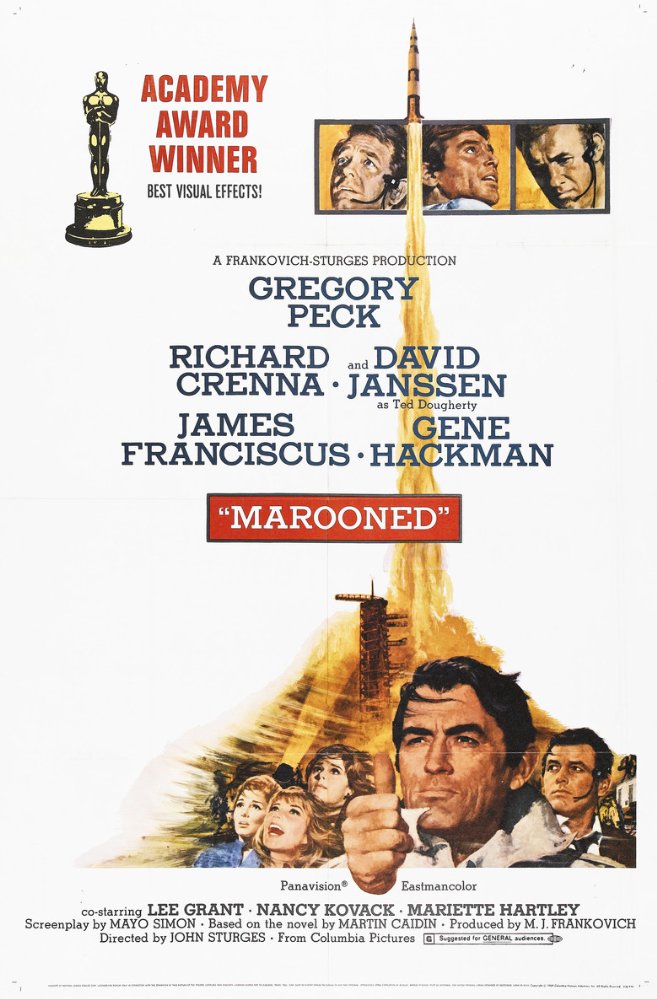Previous FilmMan Made Monster
Next FilmMars Needs Women
Marooned 1969
 | Three American astronauts are stranded in space when their retros won't fire. Can they be rescued before their oxygen runs out? |
The Cast
| Gregory Peck | - | Charles Keith |
| Richard Crenna | - | Jim Pruett |
| David Janssen | - | Ted Dougherty |
| James Franciscus | - | Clayton Stone |
| Gene Hackman | - | Buzz Lloyd |
| Lee Grant | - | Celia Pruett |
| Nancy Kovack | - | Teresa Stone |
| Mariette Hartley | - | Betty Lloyd |
Film Trivia
In the film, the astronauts are seen using what appears to be the early concept of the Manned Maneuvering Unit - during the real-life Skylab missions, the Astronaut Maneuvering Unit (the AMU) was tested inside the space station and never tested in the vacuum of space. The first use of the MMU was during STS-41-B (the fourth flight of the Challenger) on February 7, 1984.
The Film Ventures International re-edit of this film (retitled "Space Travelers") was featured on an episode of Mystery Science Theatre 3000 (1988). This was also the only film featured on the show to have won an Academy Award.
There is no musical score for this film. Instead, each spacecraft has its own ambient soundtrack when it is shown in space. The Apollo shots feature a low hum; the XRV, a hollow ringing; the Nimbus Weather Satellite, a rapid series of beeps ascending in pitch; and the Russian Voshkhod, a constant pitch series of beeps. The only exceptions to this is are a very slight, muted bit of music played under the Apollo ambient soundtrack during Pruett's final EVA, and a single tone (with some ambient effects that could be called music) during the opening credits.
Was the impetus behind the 1975 Apollo-Soyuz Test Project where American astronauts and Soviet cosmonauts docked in space.
Frank Capra began work on the film. Inspired by his work on the Martin-Marietta Corp.-commissioned faux documentary, "Rendezvous in Space" for the 1964 World's Fair in New York, Capra (a chemical engineer by education) worked to make the picture for Columbia, but finally abandoned the project in preproduction in May 1966 when he couldn't bring the budget down to the $3-million required by Columbia worldwide production chief M.J. Frankovich. The eventual budget for the finished film (directed by John Sturges) was $8 million. Capra never made another film.
At the launch of the rescue craft during a hurricane, the Cape Canaveral press corps is portrayed by the reporters themselves, though they are virtually unrecognizable in rain slickers and other gear. (As related by Sue Butler Hannifin then a space reporter at the Cape.)
XRV is a lifting body shape used in tests then & basis for DreamCatcher shuttle now for NASA.
The space station using a spent Saturn S-IVB stage was based on early proposals during the Apollo Applications Program; at the time of filming, what came to fruition as Skylab was still under development. The only differences between the orbital workshop depicted in the film (which has a rocket motor attached) and the real Skylab was the incorporation of the Apollo Telescope Mount and two docking ports on the docking module, not to mention the absence of a rocket motor. The real Skylab was launched as a 'dry' workshop using a surplus Saturn V #SA-513 (originally earmarked for the canceled Apollo 18 mission). The three-man crew in the film spend 5 months living in space; the longest duration in the real Skylab was 84 days during the final mission, Skylab 4.
The film was a major box office flop.
Based on a novel by Martin Caidin, who would later write "Cyborg", the basis for the TV series The Six Million Dollar Man (1974).
Final film of Nancy Kovack.
MST3K did this movie under the title "Space Travelers". Of the over 200 movies the crew poked fun at, this contained substantially more stars and may be the biggest-budget movie they ever lampooned.
In the original novel, it was the Jim Pruett character who is Marooned in a Mercury capsule who is rescued by the Ted Dougherty character in a modified Gemini capsule.
Average Shot Length (ASL) = 8 seconds
An excerpt of this movie appears in Alfonso Cuaron's "Roma" as a glimpse to his own space film "Gravity".